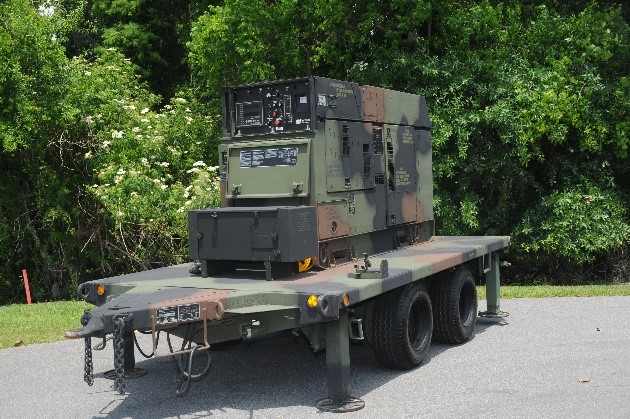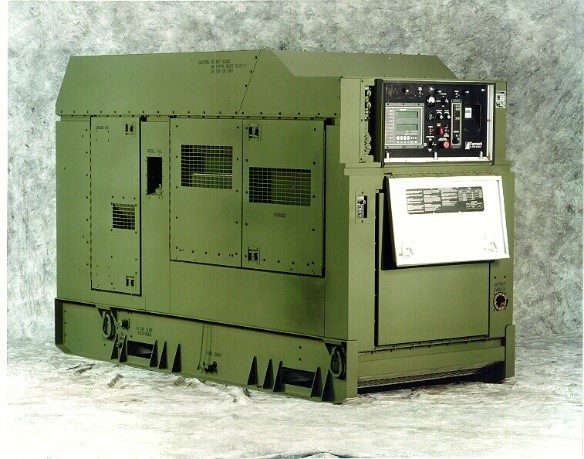Product Lead Large Power Systems
MISSION:
Provide integrated, scalable, and affordable large power generation and distribution materiel solutions that increase mission endurance, reach, and survivability for warfighters across a range of multi-domain operations.
VISION:
Serve as the DoD lead standardization activity for emerging large tactical power and sustainment solutions; be a key enabler of Army Cross-Functional Teams (CFTs) through advanced and reliable force modernization.
VALUES:
Integrity, Innovation and Dedication.
FOCUS:
Product Lead Large Power Systems (PL LPS) provides warfighters with large tactical electric power solutions that are more than 100kW.
100kW/200kW Tactical Quiet Generator (TQG):
100kW TQG:
The 100kW Tactical Quiet Generator (TQG) was a ten year production contract, the final ordering period closed in March 2014. This program's mission was to satisfy a requirement to replace the 100kW Military Standard (MIL STD) generator. This generator was fielded to the Army, Navy, Air Force, and Marine Corps. This acquisition produced more than 2500 generator sets possessing the same desirable characteristics as other generator sets in the TQG family such as: less weight, diesel/JP-8 fueled, reduced aural signature, quality power output, improved reliability and maintainability, and decreased procurement and operational / maintenance costs. This program resulted in the procurement of both skid mounted or trailer mounted (Power Unit) versions of the 100kW TQG. The 100kW TQG was developed by DRS Fermont located in Bridgeport, CT.
200kW TQG:
The 200kW Tactical Quiet Generator (TQG) production effort closed in September 2010 as Caterpillar ceased engine production. This program's mission was to satisfy a requirement to replace the 200kW Military Standard (MIL STD) generator. This generator was fielded to the Army, Navy, Air Force, and Marine Corps. This acquisition produced more than 300 generator sets possessing the same desirable characteristics as other generator sets in the TQG family such as: less weight, diesel/JP-8 fueled, reduced aural signature, quality power output, improved reliability and maintainability, and decreased procurement and operational/maintenance costs. This program resulted in the procurement of both skid mounted or trailer mounted (Power Unit) versions of the 200kW TQG. The 200kW TQG was developed by DRS Fermont located in Bridgeport, CT.
Prime Power
840kW, Deployable Power Generation & Distribution System (DPGDS), MEP-PU-810A/B

The MEP-PU-810, Deployable Power Generation and Distribution System (DPGDS) Prime Power Unit (PPU) is a wheel-mounted, dual diesel engine driven, prime power (Type II), utility (Class 2A), Mode I unit that produces 840 kilowatts (kW), 4160 volts line-to-line at 60 Hertz (Hz) and 700 kW, 3800 volts line-to-line at 50 Hz with an 0.8 power factor, lagging. The MEP-PU-810 was configured in two versions. The USAF version, the MEP-PU-810A, was a new family of air transportable bare base electric power generation and distribution systems to support the Air Force’s Harvest Falcon and Harvest Eagle expeditionary mission sets. It is in a towed trailer configuration that is capable of being air transported by a C-130 aircraft. The U.S. Army version, the MEP-PU-810B, was designed to be more maneuverable in support of ground elements. It was designed with a fifth wheel configuration approved by the Department of Transportation (DOT) for over the road use at 55 miles per hour (MPH). The system is capable of powering distribution networks to customers up to a distance of two miles away via transformers at 208/120 volts alternating current (VAC). Capable of operating in both the Auto, Manual and Utility modes, the DPGDS allows flexibility of monitoring and controlling operations from Generator Control Panels (GCPs) and/or remote operation via the Operators Remote Terminal (ORT). This capability allows the system/or an operator to start, stop, add and remove generators, operate in parallel, and provides the ability to form a power grid.